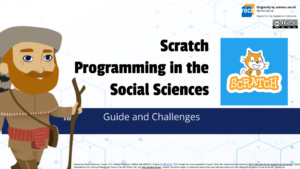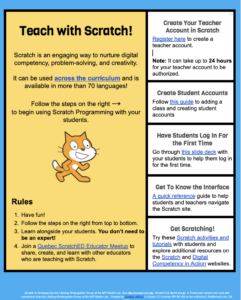Students
Scratch is a free open-source programming software that was developed by the MIT Media Lab. It is available in many different languages and is used by people all over the world to create animations, games, and more!
Are you interested in using Scratch in your Social Sciences class? Here is a guide that includes challenges to get you started! Check out the last slide for more project ideas using Scratch software!
Teachers
Scratch is an engaging multi-disciplinary tool that can be used across the curriculum to work towards program-specific targets and competencies. It is also a fantastic way to activate Digital Competency. You can learn more about Digital Competency and the Digital Action Plan by visiting the Digital Competency in Action website.
Are you just beginning to explore the use of Scratch in the classroom? We have created a hyper doc to get you started teaching with Scratch. You can click on the image on the left of this paragraph to view the hyper doc as a Google document. It provides and overview of how to create student accounts, as well as tips, tricks, and project inspiration for your class.
After you have created accounts for your students, you may want to share the above slide deck with your students. You can complete some of the getting started challenges together. After this, you may want to explore the following projects for the social sciences that were created by RÉCITUS and/or the LEARN/RÉCIT team for the Anglophone community. Note that some of the below activities require a Makey Makey microcontroller. This is an affordable microcontroller that is already available in many schools. Vist the resource section of the Digital Competency in Action website for more information about Makey Makey microcontrollers (including teacher’s guides and activities).
Scratch Activity Guides for Elementary Social Sciences:
Historical Figures (Various societies and time periods)
Interactive Timelines (Various societies and time periods)
New France around 1645 and 1745

